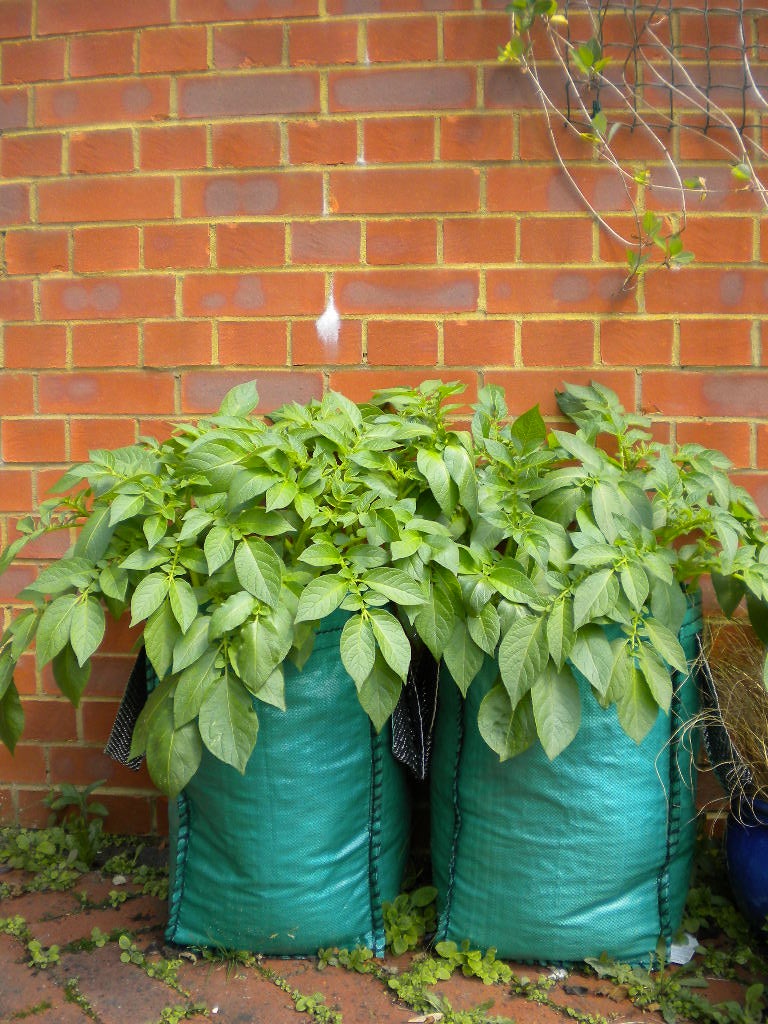Raised Potato Plants – Methods For Growing Potatoes Above Ground

Potatoes go with just about everything, plus they are fairly easy to grow, so it’s no wonder that many gardeners plant them in the usual way, underground. What about growing potatoes above ground though? Raised potato plants may be an atypical potato growing method but one with many benefits. Read on to learn how to grow above ground potatoes.
Benefits of Raised Potato Plants
Potatoes actually don’t need to be buried under dirt to grow. The reason we do is simply to keep the potatoes from getting green, but there are other ways to accomplish that. The key is to block the light from hitting the actual spud.
The advantages of growing potatoes above ground are numerous. First of all, digging the spuds up at harvest often damages them. Growing potatoes above ground eliminates that problem.
With this potato growing method, you are replacing the dirt with mulch and that has all kinds of benefits. For one thing, it’s a great way to clear a weedy area in the landscape since the mulch blocks the light. At the end of the growing season, the mulch breaks down to add more organic matter in the soil.
Potatoes from raised potato plants will also likely be the nicest looking potatoes you’ve ever grown. They won’t be dirty and will be smooth.
Above Ground Potato Growing Methods
There are basically two above ground potato growing methods: raised potato plants grown in a raised bed or potatoes grown in a tower or cage. There are variations on either method, but here is the gist.
How to Grow Above Ground Potatoes in a Tower
A day or two prior to planting, cut certified disease-free seed potatoes into 2 inch (5 cm.) chunks with at least two eyes per chunk. Lay them out to cure for 12 to 48 hours to allow the cut side to scab over. If you are choosing the tower potato growing method, you will need 12 to 24 pieces per tower. Choose longer season varieties or indeterminate potatoes which will set more potatoes over a longer period.
Gardening tips, videos, info and more delivered right to your inbox!
Sign up for the Gardening Know How newsletter today and receive a free copy of our e-book "How to Grow Delicious Tomatoes".
To grow above ground potatoes in a tower, you will need metal field fencing. Fold the fencing into a cylinder that is about 2 to 3 inches (5-8 cm.) in diameter and secure the ends. Choose a spot for the tower and fill the bottom third with straw and then a layer of soil. Place the seed potatoes near the edges of the container and about 6 inches (15 cm.) apart.
Repeat the process until you have layered in all of your seed potatoes. Cover the top of the container with mulch, flowers, or even salad greens.
Growing Raised Potato Plants
To grow above ground potatoes in a bed, either create a raised bed or mound up dirt to create a long bed. Hoe or loosen the soil if need be and water the area. Lay the seed potatoes spaced just as you would if you were burying them – early varieties 14 to 16 inches (35-40 cm.) apart with at least a foot (31 cm.) between plants and for other varieties 18 inches (46 cm.) in a bed or 14 inches (35 cm.) between plants in rows that are 30 inches (75 cm.) apart.
Cover the seed potatoes with just straw or compost and then straw. You can either cover them with 6 inches (15 cm.) of straw right away or add to the straw layer as the potatoes grow. Water the straw well and cover it with mesh or grass clippings to keep it from being blown away.
No space? That’s okay too. Growing potatoes in containers or grow bags will also suffice. You can layer this with straw and compost just as you would in a tower.

Amy Grant has been gardening for 30 years and writing for 15. A professional chef and caterer, Amy's area of expertise is culinary gardening.
-
 Moody Blooms For Spring: 8 Types Of Black Flowers To Add Drama To Spring Displays
Moody Blooms For Spring: 8 Types Of Black Flowers To Add Drama To Spring DisplaysFrom midnight burgundies to inky violets, several types of black flowers can enrich and embolden a spring display. Try these brooding bloomers for a moody garden
By Tonya Barnett
-
 Can Snake Plants Live Outside? Everything You Need To Know For Snake Plants Al Fresco
Can Snake Plants Live Outside? Everything You Need To Know For Snake Plants Al FrescoSnake plants can live outside given the right conditions, but be careful that they don't take over! Learn the best way to use snake plants in your landscape.
By Mary Ellen Ellis